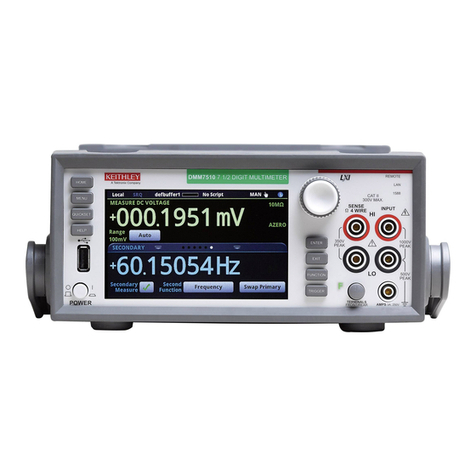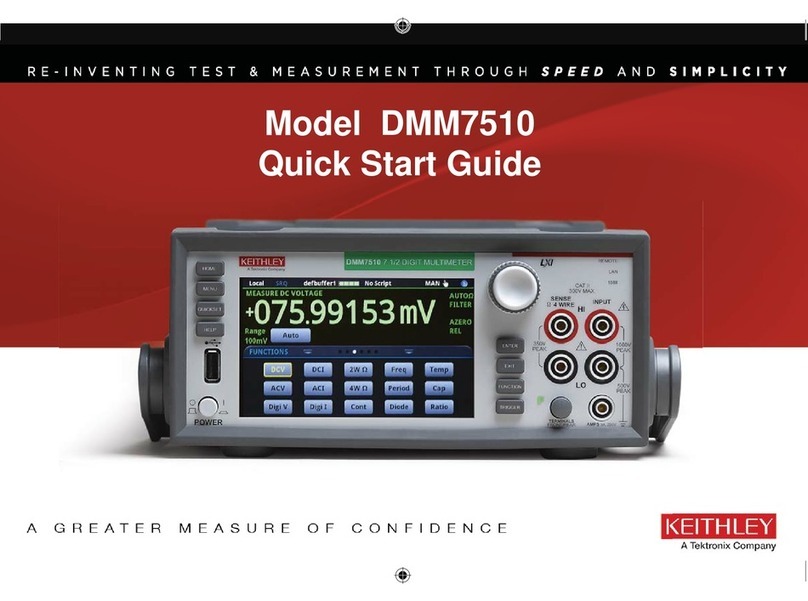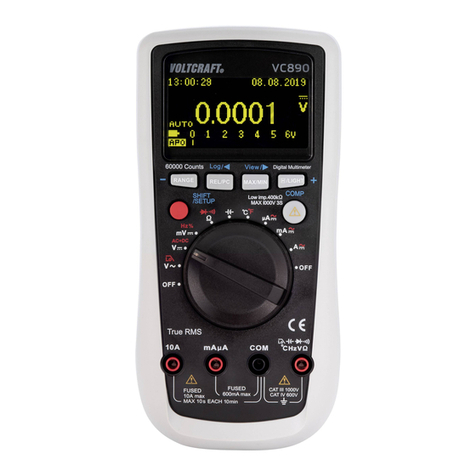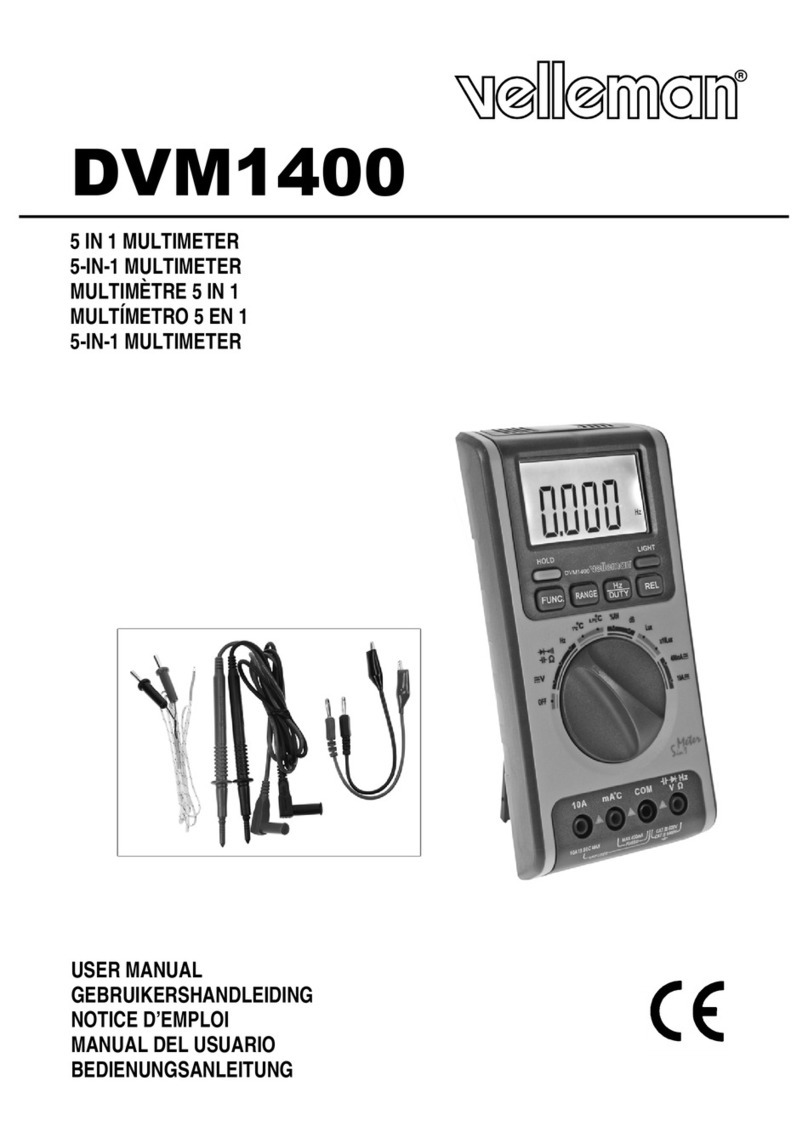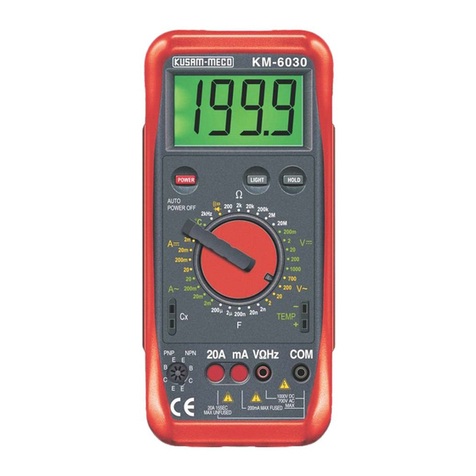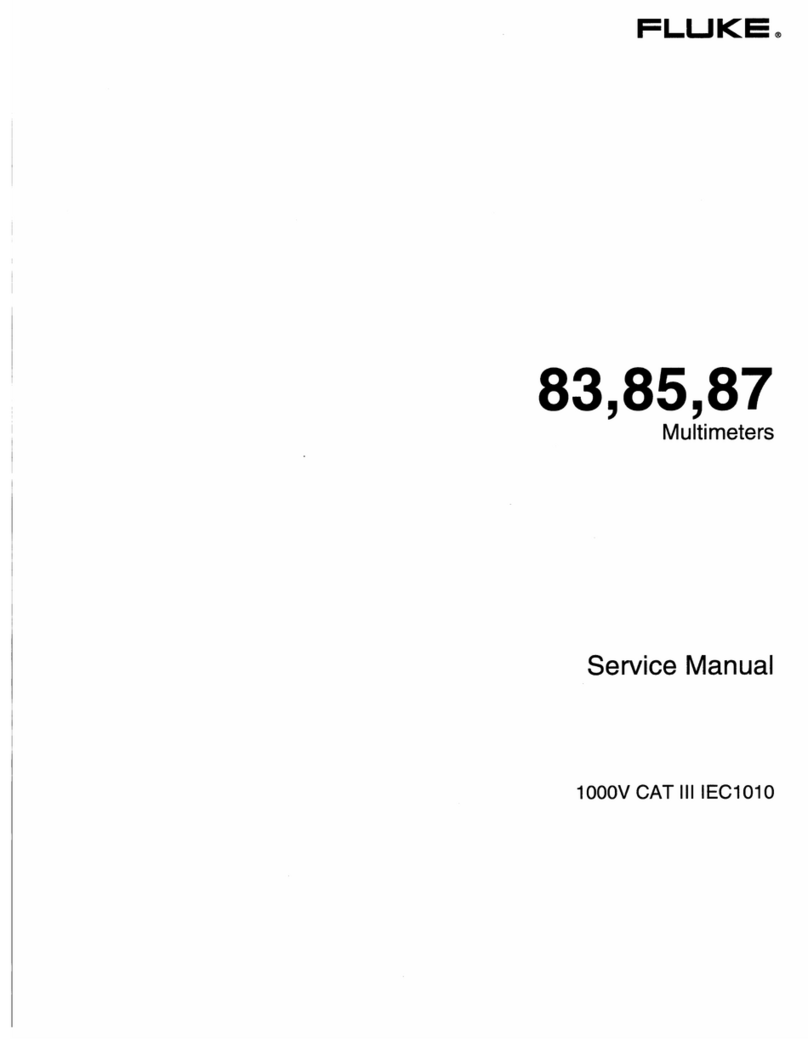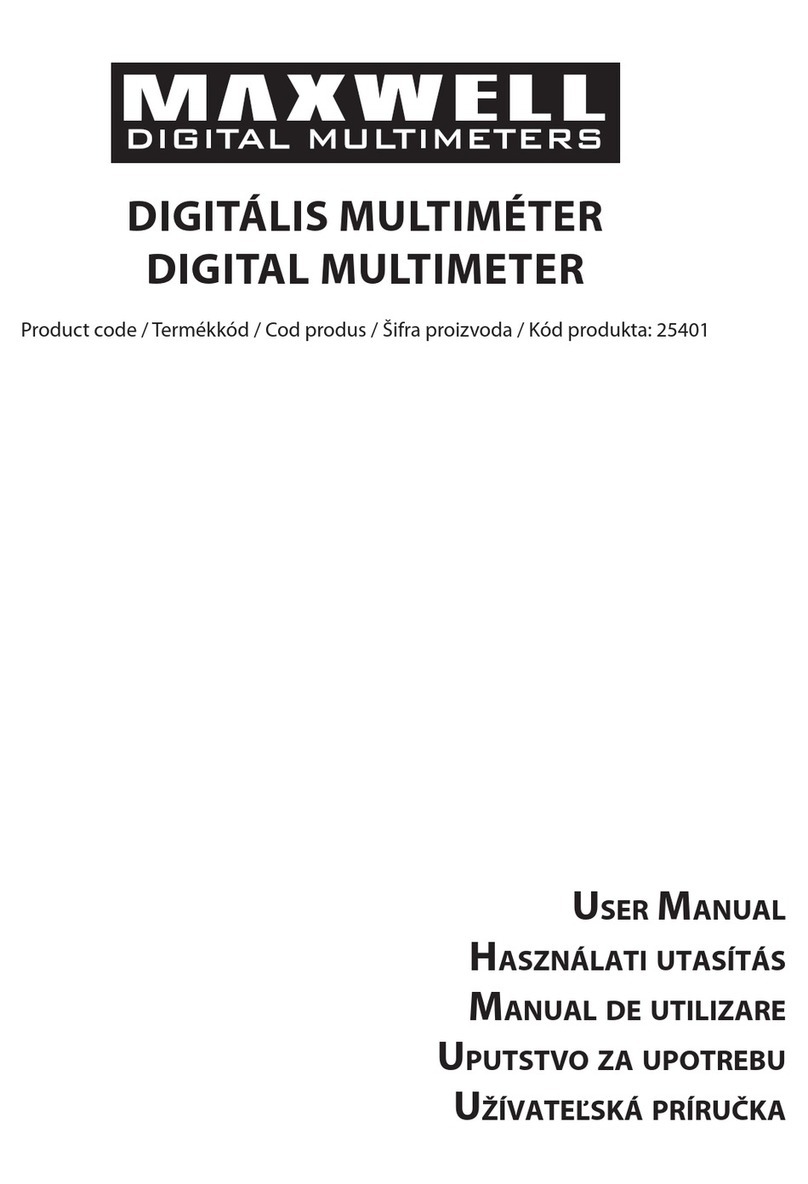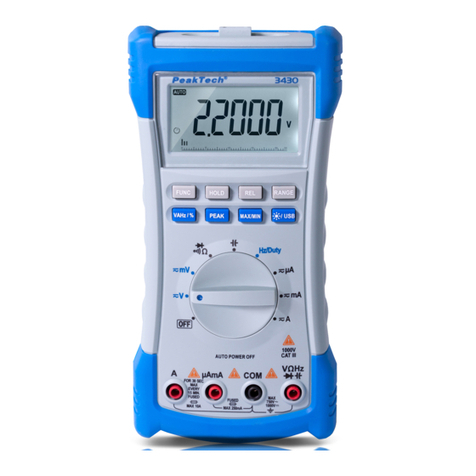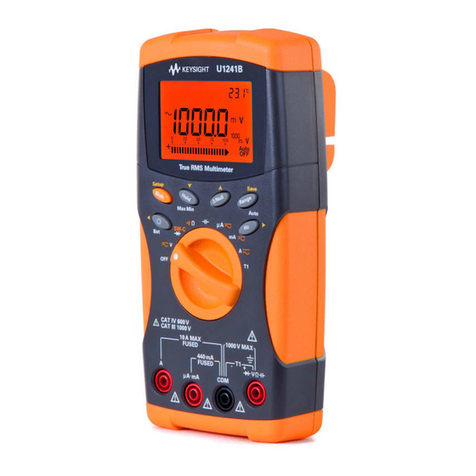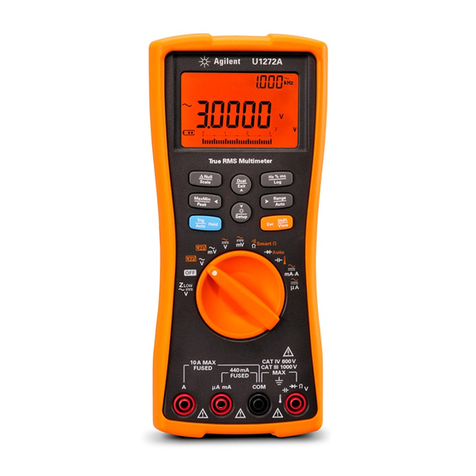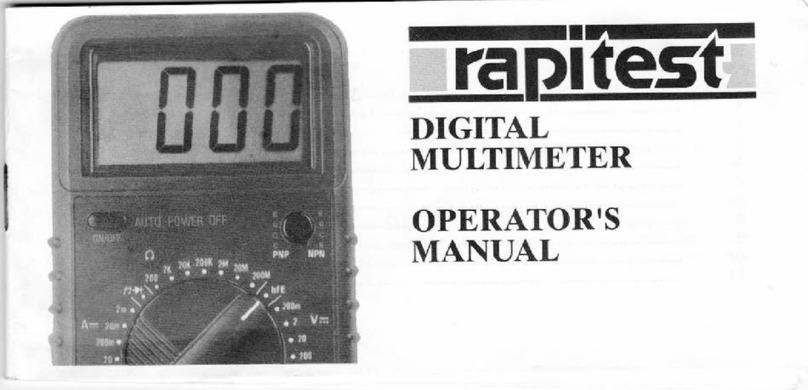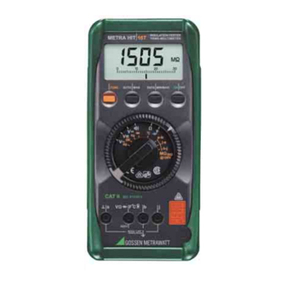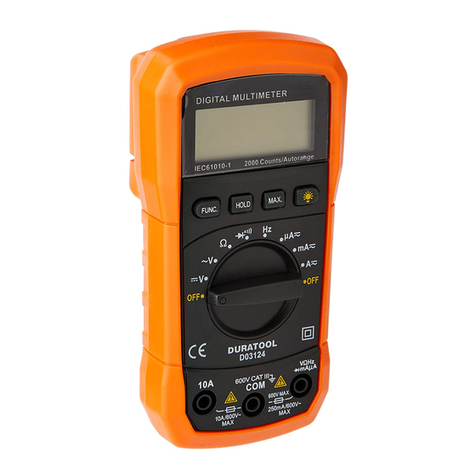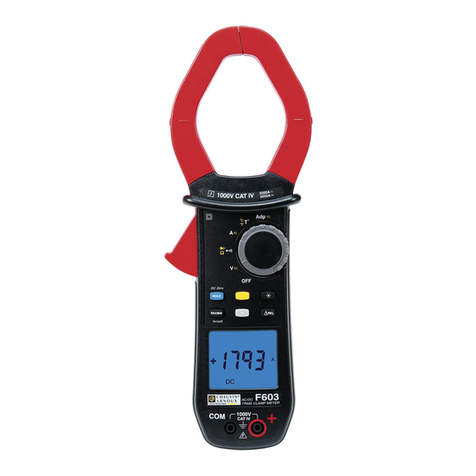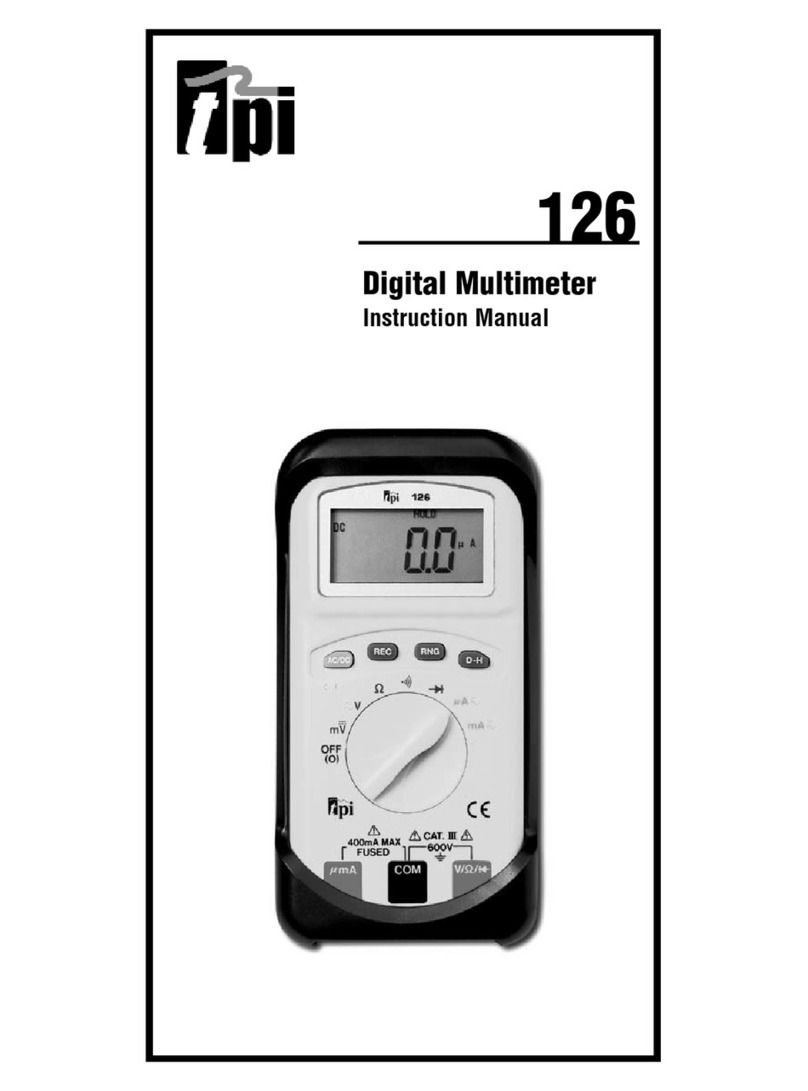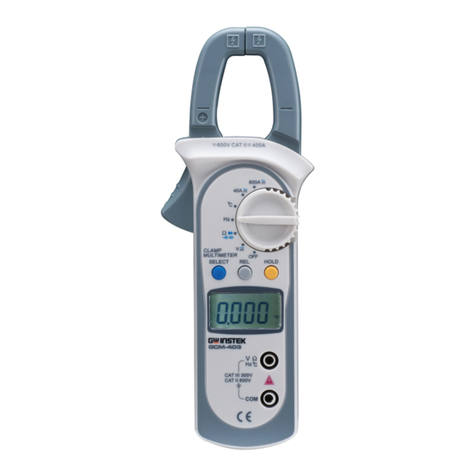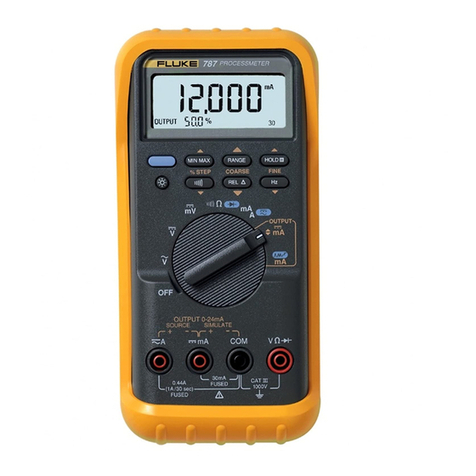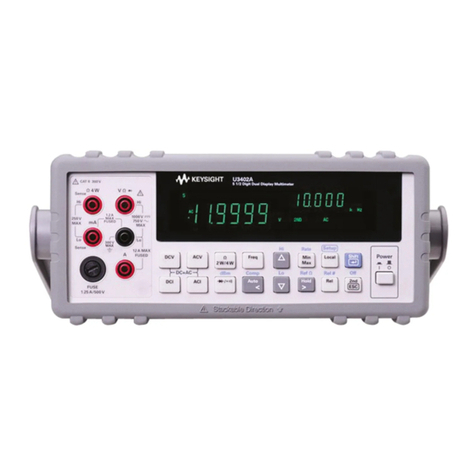Keithley 165 User manual

INSTRUCTION MANUAL
MODEL I65
DIGITAL MULTIMETER
0 COPYRIGHT 1975 KEITHLEY INSTRUMENTS, INC.
PRINTED JANUARY,
1977,
CLEVELAND, OHIO U. S. A.

CONTENTS MODEL165
CONTENTS
Tit12 Page .
CO”td”LS . . .
LiSC Of IllusCrac.ions. . .
Specifications . . . . .
1. General DeSCriprion
1-l. Introduction . .
l-2. warranty Information
1-3. Change sotice. . .
1-4. Features . . .
3. circuit Descripeion
3-1. General. . . . . . .
3-2. *c-"o1cs Preamplifier. .
3-3. DC-vo1rs PraamplFfLer. .
3-4. OhrnPcircuitry . . . . .
3-5. 1-d currene source. .
3-b. DC-r\mpsPreamplifier .
3-7. *c-Amps Preamplifier . .
3-8. hipolar Amplifier . .
3-9. AD ConverCer . . . .
3-m. Clock. . . . . . . .
3-11. Logic. . . . . . . . .
3-12. Display. . . . . . . . .
1-13. Power supply . . . . . .
4
5
5
5
5
6
7
. 8
. 9
9
10
. 10
. 10
. 11
11
. 11
. 11
. 11
. 12
. 13
. 13
. 13
. 13
4. Accessories
4-1. General. .
4-2. operating Instructions .
4-3. Model 1651 50-Ampere S~UOL
4-4.
Model 1653 Rack Mounting K~L
5. Maintenance
5-1. General. . . .
5-2. Recommended Tesr Equipment
5-3. Performance YerificaLia" .
5-4. Calibration. .
5-5. companenr an* Calibration
Layouts . . .
5-b. some Semiconductor case ouc1ines
and Pin Identificarions .
5-7. Tra"bleshoati.ng. .
6. Replaceable P,,CS
b-l. General. . . . .
b-2. Electrical Schematics and
Diagrams. . . . . . .
b-3. How to "se the Parts list. .
b-4. HowLOOrder Parts . .
6-5. Chassis Pares List .
b-6.
Electrical Parts List. . .
6-7. Mechanical Parts IAt.
b-8. Code-to-Name List, . . .
7. scbmatic Diagrams
7-l. 253950 Block DFagram. . . . .
7-2. 2539ZE AC & DC Preampltiier
SwiCchtig . . . . . .
7-3. 253930 "*ipolar Amplifier 61
A-D canverrer . . .
7-4. 255080 Clack & Switching Logic.
7-5. 25511D Re y b Drivers. . .
7-6. 25394E Readout and logic.
7-7. 25391c Power supply . . .
15
15
15
15
16
16
16
20
27
29
31
34
34
34
34
35
35
49
50
52
53
54
55
56
57
58

ILLUSTRATIONS
‘ii
t .

SPECIFICATIONS
AS A DC VOLTMETER

SECTION 1. GENERAL DESCRIPTION
I h,.:, ,‘,I,.,.:\’
I4
165 AUTORANGING MULTIMETER

POWERON CR”“Nu INPUT INPUT
s-301 3403 ‘0 HI SOURCE S40lA S4OlB
5402 3401 5402

CAL CONTROLS ANALOG CAL POWER LINE LINE FLiSE
OUTPUTS CONTROL INPUT SWITCH SWITCH F301
P304 5303 s302

MODEL165
SECTION 2.
1. Tbermoelecrric Naise. Potentials generate*
by rhermal differences Bf rtle junction a= ,unctions
of Ed0 dissimilar metals are thermoelectric noises,
more commn1y called thermal mm. These potencia1s
may be significant when making millivolt or mic=o-
volt mea*uremencs. TO minimize ehermal nOiS* ---
which may appear as a drift --- caused by thermal
FXYO, use PUT* capper circuirry emi tswinaricms
thrau*iw*t the source an* in a11 connectians to
ehe 165. The KeicNey accessory Model 1483 Low
Thermal Connection Kit contains all necessa=y ma-
cerias for making very law-thermal copper connec-
tions for minimir*n* tharmal mm..
2. AC Power Line Noise. The presence of electric
fields generated by power lines o= other power
.9O"TceB can haYe an effect 0" inaaur,ent operarim.
Also ac vok?.ges presenr in Ehe BOUrCe which are
very large vith reapact. to the full-scale range
sensitivity of the Model 165 could drive the analog
amplifier into sa~uracio". producing an e==OneO"a
digiral display.
a). Shielding. Proper shielding of the sowxe
or cabling can minimize noise pickup when the
instrument is in tile presence of large ac fields
or when very seneirive me*e"rements are being
rude. ‘ornoiae shielded cable, such as Keith+,
SC-9 cable, should do a sufficient job of shield-
ing rhe inpur signal. Metal shields may be re-
quired LO be installed arD""d the BOUIICB. me
shields of the inpur cable and source should be
connected together co ground at ooe point only,
typically at the input of the Model 165. This
one-point-ground method ia a frtree'f configuracio",
which minimi=es ground L,ape in the measured cir-
cuiery. Ground loops are a secondary source of
interfering noise Which may also be considered in
larle"el meee"reme"ts.
OPERATION
b). AC Ke,ecrim. The Model 165 provides
artenuation of line frequency noise superimpose*
on a dc input signal. The ac re,ection Of the
165 is specified as follows:
NOWL MODEkE.lECTION RATIO (NMI(Io: Greater
than
60
dB above one digit for a voltage of
line frequency o= twice line frequency with
at leas= 10% of full-range dc applied.
COMmN MODEREJECTION RATlO (cxea): 120 dB
on the 10 mv, 100 mv. and 1" ranges; 80 da 0"
the 10" range; 70 da on the 100" range; and
60 dB an the 1000" range; far a dc, 50 HZ, o=
60 Hz voltage with at least 10% of full-range
dc applkd.
3. Magnetic-fFeld Noise. The presence of strong
magnetic fields can be a possible so"=ce of obJec-
eionable ac noise. The Model 165 has been suffi-
ciently sbialded from typical magnetic incerfarence;
however, additional shielding may be required at the
eo"rce or in the cabling to the 165. Magnetic flux
lines which cue a conductor --- like an input cable
--- can produce large ac noise, especially at power
line frequencies. me voltage induced due to nag-
neric flux is proportional to the area enclosed by
the Circuit *s well as the rate of change of mag-
netic flux. POC example, the motion of a ,-inch
*iemeeer loop in the earth'. magnetic field will
induce a signal of several tenths of a microvolt.
The ac rejecrion characteristics of ebe Model 165
vi.11 help minimize specific effects of magnetio
fields. Magnetic pickup may be furthe= minimized,
by arranging all so"=ce and input-cable wiring so
L&E the loop area enclosed 18 BB small as possible
(such as by rwisring input leads). "sing conetic
(magnetic) shielding in cables and around cirwia-j
may further help in seve=e cases.
b. Effective Shielding. Here are general shielding
rules fo consider far measurements in the three func-
tion categories of the 165. Be sure that shielding
is even needed before proceeding.
1. Yolemeeer maaurements. Consider shielding
input leads when sou=ce resistances a=e g=eaCe= than
100 kilc,hm o= when long input cables are used. Avoid
even slight movements of input cabling a= Ct\e oource
when making high s.au=ce resistance measurements.
2. C"rrenC Mea8"reme"C*, on the mA and ii.4 current
ranges, generally no ape&a1 shielding precautions
need ba taken. However, consider shielded input
leads for me~~"=ements an the lowese ranges.
3. Reeiscance *easuremenc*. Shielding Of the
input cabling and sou=‘ce may be necessary far meas-
"remente on the 10 megohm and 100 megohm ranges.
4 1073
.~.
P .

C. If 400 HZ line “OlrageS are LObe used, COnSUlt
the factory applications deparcmenr or your local
Keithley rrpresenrarive for instructions.
d. Turn ox power Switch 5301.
2-3. CONNECTIONS. (refer ta Figures 2 and 3).
a. Innut. Three binding posts are provided an
the frO"C piln.21 LOT input connections. The cermina1s
are color-coded a* follows: red = input high (HI)
5401, black = input low (LO) ,402, and green = power-
line ground (Clm) ,403. These terminals mace Wifh
individual "ban*"*" plugs similar LO Keichley Parr
NO. c-5, The from pane1 terminals are spaced with
,/Ii-inch bewee" centers to mate wit,, a standard
dual "banana" plug such as Keitbley Part No. Lx-,.
Banana-plug-co-alligator-clip cables (available
through my local electronics supply house), such as
two Keithley Part No. 181620 cables, are ideal for
fast connections to the 165 input. The shorting link
provided at the input should be connected between LO
and cm for grounded operacian. IC is preferable,
to minimize rhe pas5ible effects of ground loops
(small mrrents flowing in the ground system), that
there be only one ground point in the measuring
syseem. If possible, connect all grounds together
at one poinr, ideally ac the CND input terminal of
the 165. 'Tire input ShorrFng link should be removed
for floaLi"g OpcrdLiO".

b. AC VOLTS OwraCion. The Model 165 provide5
five and one-half decades (six ranees, of ac vo1caee
T .

2. I”WL Resistance. me input reSiSCa”ce of
the 165 on all ac voltage ranges is I megohm 110%
shunted by less rhan 75 picafarads of capacirance.
3. Accuracy. The Model 165 detects the average
value Of a" applied input ac waveform. The display
of the 165 is calibcnted LO indicate the n,,s value
of an applied sinewave. The accuracy (error Limit)
calculations given in Paragraph Z-ha, ah.0 apply
far ac measurements, except cilai 20 HE and ZOlcHZ,
the specified accuracy is asymmetica1. Reference
the specified ac-volts accuracy ranges a~ 20 Hz,
lkkiz, an* 20w*. Typical aCCUraCy bands at non-
specified frequencies ace shown in Figure 6.
5. rlaximum Allowable Input. Ihe maximum contin-
uous or i"termifLe"t input voltage which calI be
safely applied 0" manually selected l-volt and lower
ranges is 250 "0lt.S rms. when aperacing manually
on the 10 volt to 500 volt mls ranges or in the
auroranging mode on a11 ranges, the maximum con-
cinuous or inrermiCce*t inpur voltage which can
be safely applied is 1200 volts peak ac + dc. on
the 5O&volc rms range (1000 volt range pasitio")
in either ranging mode, the 165 display will flash
when the inpui exceeds 499 volts rms, although a
reading beyond this level is displayed.
2-7. OPERATIONAS AN AXXETER. The Xodel 165 can be
used to measure C"rre"L from 21 nanoamp to t2 amps
dc and 100 nanoamps to 2 amps C"S ac. 3. Accuracy. The dc-current accuracy Of the
165 is t(o.3% of reading + 0.3% Of range). The
error limit of a given measurement can b< Cal-
culated using this specifiearia" (see Paragraph
Z-6=3) and the voltage burden (see Paragraph Z;i,l,

OPERXION
diodes Will prorect the sensing resistors from cur-
renfs UP to levels which cause excessive heating or
vaporization of pc-board tapes.
1. Measuremenr Procedure. Selecr ehe AC AMPS
function using the FUNCTIONswitch, set the RANGE
switch. and make input connections to the front-
pane1 cermina1s. The digital display indicates
the decimal point locaeion and engineering units
Of a reading. The polarity Lag” “ill not light
when AC amps is eeleceed. If the display exceeds
1999 on the 100 milliamp or lower raoges, the three
right-hand digits will blank and ehe overrange "1"
digit will remain lit. See Paragraph 2-?a5 far
details af the maximum allowable Fnpur.
2. Input Resistance. See Paragraph 2-7a2.
3. Accuracy. The aC-C"rre"f accuracy apecifi-
cation of the 165 is used co calculate the error
limit of a Specific mea*ureme"t (see Paragraph
2-6a3). except at 20 Hz and 2OkHz where specified
accuracy is asymmtri~al. Reference the specified
ac-amps accuracy ranges a~ 20 "z, lkI+z, and 2O&.
Typical accuracy bands af non-specified frequencies
are shown in Figure 6, alrhough rhe 10-1000 mA
ran8e has somewhar flatter responsa at 2Ok"z than
char shawn. Voltage burden (see Paragraph 2-7b2)
can also produce error, depending on the level of
rhe source "alcage.
4. Half-dIgit I"terpo1ari.o". see Paragraph 2-74.
5. Marimum Allowable Input. See Paragraph 2-7a5.
2-8. OPERATIONAS AN OHMMETER. The Model 165 can be
used COmeasure resistance from 0.1 ohm co 200 meg-
ohms. The Model 165 ~ravides se"en full-range decades
of resisrance fram 100 ahms LO 100 megohms. Range
seleccio" can be accomplished either manually x
autamarically. w selection is accomplished by
setting the RANGEswitch S401B LO any ""e of seven
positions, g including the secand position from
full clockwise. i"his wsicion may be used but it
just duplicates the operarion of the 100 megohm
runs, which is the third position from full clock-
*
NODEt 165
wise. As the RANGEswitch is rotated counterclock-
wise. the 165 resistance sensitivity is increased.
Automatic selection of range is accomplished by
rotating the RANGEswitch to rhe extreme clockwise
position marked AUTO.
a. Measurement Procedure. Select the OHMSfunc-
tion "siw, the FUNCTIONswitch. set the RANGEswitch.
and make input c""necrio"s t" ;he front-pa"el ter-
minals. The digital d$splay indicates decimal 1
location and engineering units of a reading. ':
POlEdry sign "ill not light when ohms is selec:~
If the display exceeds 1999 "n any range, the three
right-band digits will blank and the overrange "1"
*igir Will remain Iit. 1" the AUTO mode or manually
on the oueside IOO-megobm position, a" open-circuit
input ca"~es a flashing 01.7 W display. With an
open in~ue, the inside IN,-megohm range, the third
p"si~ion from full clockwise, may flash or blank de-
pending a" whether it was entered from the outside
lOO-megobm renge or the lo-megohm range. Also, if
the RANGEswitch is rotated rapidly while in the AUTO
made, the display may blank. Neither candician just
discussed represents a problem or malfunction.
aa shown in Table 2-4. The HI input t&inal 5401 is.
negative with respect to the LO input terminal 3402.
The rermina1 voltage is 100 mulLvolts at full ranz>.
(200 millivolta at maximum overrange reading).
maximum open-circuit voltage is less than 1 volt.
TABLE 2-4.
Ohm Test C”rrenr
Full Pull-Range Teat
Range Terminal VAtaga Current
100 n 100 In"
1 k0 100 02"
1~0k" I"0 rn"
lm.4 ,.
100 "A
10 p.4
100 kn 100 I"" 1 UA
1 I% 100 r&Y 100 "A
10 MO 100 mv 10 "A
100 ML-z 100 mv 1”A
C. *muracY. The accuracy far all abms ranges is
as specified. This apecificario" applies far envi-
ronmental conditions of 35'C at up to 10% relative
humidify. Accuracy on the l-megohm and higher ranges
is typically two-times better than specifications.
The error limit of a given mea*urement can be cal-
culatcd using the specified accuracies as described
in Paragraph 2-6~~3.
d. Half-digit Interwlation. When the m"st right-
hand digit of the 165 display is flashing berwee" two
adjacen; numbers, the percentage of time spent on each
is a half-digit intarpalario" of zhe incoming signal
level. POT example, 1.000 kilOhmS flashing in near-
equal intervals LO 1.001 kilobms would indicate a
reading of 1.0005 kilobma.
e. Maximum Allowable Input. The maximum Yolrage
which can be applied to the input Fn the OHMSfunc-
tion ia 250 va1ts rms on any range. This voltage
may be applied continuously or ineermictenely with-
out damage or degradation af ~pecificati""s.
1073
7,.

MODEL165
2-9. OPERATIONOFTHEl-m.4 SOURCE.The ImA front-pane1
pushbutton aCti”*fes * cLIrre*t source of +1 mA*10x.
The current 18 internally injected into the HI input
terminal 5401. voltage compliance is cypica11y *rearer
than 4 vo1r.s.
a. Reeiarance Measurements. If the DC VOLTS func-
tion is selected while usinp. the 1 mA current BOUXCB,
the Model 165 becomes a dir&-reading autora”ginS z
manual ranging ohmmeter having 100% overran&g on ranges
from 10.00 ohs co 1.000 kilohms full-scale (corresponding
respectively co 10.00 millivolr through 1.000 volt dc
***ges). Useful measurements are available to 4.00
kilohms (corresponding LO 4.00 volts on the 10.00 volt
dc range). I” any c**e. the Yoltage compliance limif
is also the 1iraiL of resistance measurements using
the 1mA C”rre”t source. Note that rhe engineerI.“*
uni~a on the display will scFll indicate volts, which
is the voltage compliance at which maaauremenrs are
being made. Af the 8-a time, the displayed numbers
in the reading indicate the value of the resistance
being measured. For example, * reading of 100.0 milli-
volts dc indicates the meaeured resistance is 100.0
ohms and a reading of 1.999 volts dc indicates 1.999
kildlm.
1. Measuremanr Procedure. The ImA current source
feature of rhe Model 165 may be used to measure low
resistances or to check continuity. A” open cir-
C”it or resisrsnce grearer aaLl the range limit is
indicated by a display of the full compliance volt-
age. This voltage ia eaefly determined by open-
cFccuiting in the input terminals of the 165 and
depressing the lmA pushburro” “bile operating in
the DC YOLTS~funcfio” eithsr manvally on the IO-
volt range or in the AUTO range mode.
2. Compensaring for Lead Resistance. A precise
value of the ImA current source (I) can be obtained
by open-circuiting the input terminals, eelecting
the DC AMPS function, and depressing rbe ImA push-
button; The resistance of the test leads and in-
ternal connections (P& CB” be directly measured
by shorting the teat leads’while in the DC VOLTS
function
and depressing the 1mA pushbucto”. The”
the measured resistance (R) cm be more arrnrately
defermined as follows:
where ” is the observed voltage during the actual
measurement of R.
b. Semiconductor Testi”~. In the DC YOLTS function
and AUTO range mode, the ImA current source may be
used to determine polarity of a semiconductor junc-
tion. The forward voltage drop of this juncria” at
lti is displayed a” the Model 165 if Lhe junction is
connecred between the input terminals in the foward
polarity. Note thaf the lmA c”rre”f *.a”rce is inter-
nally injected into the HI input terminal 5401. I”
the m palartty position, Lhe display will ,.“-
dicafe the compliance voltage limit of the current
source> which can be measured as described in Para-
graph Z-gal.
1073
OPERATION
DO NOT DEFRESSTHE 1mA POS”B”TTON WHENMTWJAL
VOLTAGE IS APPLIED TO THE INPUT TERMINALS.
Z-10. OPERATIONSSUMMARY. Condensed operating in-
structions are found on rhe botton cover of the Model
165. They are repeated here with a little more detail.
For complete details of operation. see 2-l Lbrou$h
2-9.
e. Power. Set Lhe rear-psoel line witches 5302
and S303 to the proper line voltage ~etti”Ss. Check
the fuse F301 for proper rating. Connecr the line
cord CD-7 to 50 or 60 Hz power. Set the power switch
S301 to ON.
b. Co*“aCfio”.9. connacr to the fro”=-pane1 “I
tied) 5401 and LO (black) J402 binding poet Fnput
Cemlinals . Connect the ground link between CND
(sreen) 5403 and LO (black) for grounded operation.
discon”ecting rbe link for floating operation.
Haximum allowed voltage becvaen CND and “I or LO is
l200” peak.
C. Function Selection. Set the outer dial to the
desired function: DC VOLTS, AC VOLTS, DC ANPS, AC
Ams, or OHMS. The digital LED display automatically
indicates decimal point, polarity, and-e”$ineering
U”5LS. Lack of polericy on the display on YOLTS or
AMPS functions Fndicatas ac readLngs.
d. Range Selection.
2. Automatic. Set the inner dial to the fully-
clockwise position (AUTO). In this position. the
165 automatically “prangea at 2000 digits and _
dawnranges at 179 digirs.
e. lmA current source. If the front-panel In.4
wabbutto” is depressed. arwroximatelv +ImA is in-
jected into the i,I input t&minal at ;p to appror-
imarely 4 volts compliance. Set the RANGEswitch
co DC VOLTS. For semiconductor tests. forward
voltage at ImA is read direcrly. For continuity or
resisLance measurements, resistance is read in ohms
using millivolt dc ranges in kilohmn using volts dc
ranges (limited to compliance voltage level). With
an open-circuited input actual compliance and current
can be meaaurad on DC VOLTS and DC AMPS respectively.
NOTE
DO NOT DEPRESSTHE 1mA P"SHB"TTON WHENMTERNAl
VOLTAGE IS APPLLm TO THE INPUT TERMINALS.
f. Zero. The DC ZERO potentiometer R431 on the
rear panel may be adjusted for a +O display with the
Fnput shorted on the 10 millivolt dc range or with
B” open input on cbe 1 microamp dc range.
9
T \

3-1. GENERAL. The block diagram of the Model 165 is
shown in Scbemaric 25395D. The eiS"*l applied to the
input rerminals first goes rhrough en input switchinS
network and then ie applied to'* dc or ac preamplifier.
A ""ipolar amplifier co""er‘c8 the signal to a positive
dc signal which ie the" applied to *" a-d converter.
The s-d control and display logic ie contained in the
LSI cirx"iZ. snd on the display printed circuit boards.
The numerical information corresponding to the input
signal is displayed a" LED digits. The logic properly
positions the decimal point and indicates engineering
""its. The inpur swircbitq network is cootrolled from
the logic in the AUTO range mode or from the front
panel manual range switch.
3-2. AC-VOLTS PWLIFIKR.. (see Schprmaric 2539%).
The signal applied *c ebe Fnput tenninela is coupled
through cepaci~or C401 CO a" *c-compensated ae~enuator
consisting of RN403 and C402 through C405. TN* ie
shunted by en input resietence consisting of R401 and
R437, and switchi"* is accomollshed bv meene of PUNC-
TION awitch S4Ol.A Deck No. 2: Table i-1 show* the
attenuation end gain factors ee well *a relay aate*
for each *c-volt* range.
TABLE 3-1.
AC Volts: Gains and Relay St*ce*
RN403 AMP.
;F.ANGE ATTENUATION K401 K402 K403 GAIN Q406 9407 Q40R
lO@lV I:1 ON OFF OFF xl00 OFF OFF ON
1Oh" 1:1 ON OFF
OFF
x 10 OFF ON OFF
1” 1:1 ON OFF OFF x 1 ON OFF OFF
10 V 100 : 1 OFF ON OFF x 10 OFF ON OFF
100 " 1000 : 1 OFF OFF ON x 10 OFF ow OFF
500 " 1000 : 1 OFF OFF ON x 1ON OFF OFF
CIRCUIT DESCRIPTIdN MODEL
SECTION 3. CIRCUIT DESCRIPTION
a. On the 1 Volt Range. On the 1 volt range, K401
16 closed, K402 and K403 *re open, end the siSn*l is
applied through resistors R405 end K406 to the input
of s Xl amplifier QA403. The input to this amplifier
is limited to the power supply level* by D419 end
D420. Overload voltages applied *c
the input are
dissipated in R40S and R406. SwitchinS ie accomplished
throuSh S4OLA Deck No. 6. On the 1 volt range Q406
is on, 9407 and Q4OS *re off. The output is coupled
fo the unipolar amplifier through c422 end swirching
ie accomplished through S401.4 Deck Nos. 7 and 8.
b. On the 100 Millivolt R*n*e. On the 100 milli-
"olL ran8e. the ouLp"t of QA403 is applied co a *LO
amplifier Q.4404. Q407 as on, Q406 and 9408 are off.
therefore the input siS"a1 ie amplified by * facror of
10 before being applied to the unipolar amplifier aSsin
through C422.
C. 0" the 10 Millivolt Range. 0" the 10 mini-
volt ran@, a second x 10 amplifier 9.4405 further
amplifies the signal and it 16 applied tbrouSh 4408
co the unipolar amplifier.
d. 0" the 10 Volt Se"*e. On rhe 10 vole **"Se,
K401 *"d K403.are off, K402 is on. Thus, RN403
attenuates the siSn*l by a factor of 100. The eigr
ie then applied to the emplifier chain QA403 and
QA404, "ith Q407 on, selectinS the xlO,S*i" for cb,
chain. Thus, the signal ia attenuered by 100 and
amplified by 10
for
e "et atreauatio" of a factor
of 10 bafore going to the unipolar smplifier.
e. 0" the 100 Volt Range. 0" the 100 volt **age
K403 is on, K402 and K401 *re off, end the input
signal is attetuated by a factor of 1000 before
being applied to the x10 amplifier chain. Q407
remains on and the *et *cte"u*cio" ie a factor of
100.
f. 0" the 500 Volt P.ewSe. On the 500 Volt range:
K403 remains on, and 9406 is on selectinn the xl
gain for the amplifier chain. Thus, the-net ecte"-
uafio" LB a factor of 1000. C402 and C403 *re ad-
justed to *c-compensate the *ttenu*tor KN403.
3-3. DC-"OLTS PREAMPLLFISR. (see SCbemaLiC 25392E)
The inpur signal is applied to the sttenuetor RN403
e8ein t,,rooSh ewiccb S4Ol.A Deck No. 2. The outp"t c
the attenustor, e.8 selected by K401 through K403, ie
applied tbroqh S4OlA Deck No. 4 and limiting resie-
tars R420 and R421 to the input of * dc amplifier *L
S401A Deck No. 5, “‘DC INPUT”.
a. DC Amolifier. The dc amplifier consists of a
FET modulator Q4OLA end QLIOlB, protected by D410
through 0413, e" ac empltiier QA403 through QA405
whose bW.n is controlled as in Paregraphs 3-2, e
demodulator 9409, and a final dc ampIFfier coosis-
ring of QA406. The output of this mep1if1er "DC
PREAMPOUTPUT” is fed back to the input by resistanct
elements in RN403, selected by K404 and K405. These
relays select Paine of 1, 10, or 100. Table 3-2
shows the attenuario" gain fsctors ** well a* relay
states for each dc-volts **"Se.
TABLE 3-2
DC volts: Gains and Relay Stetee
RN403 AMP.
UNGE ATTENIIATION K401 K402 K403 GAIN K404 K40
1hnV 1:1 ON OFF OFF x100 OFF OFF
1oomv 1:1 ON OFP OFF Y 10 ON OFF
1" 1:l ON OFF OFF x 1 OFF ON
10 v 100 : 1 OFF ON OFF 1 10 ON OFP
100 ” 1000 : 1 OFF OFF ON xl0 ON OFF
1000 v 1000 : 1 OFF OFF ON x 1 OFF ON
b. Modulator and Demodulator. The modulator and
demodulator are operated at e frequency of 220 Kz.
This is developed at the "t44" output of the LSI
chip *"d appears in the middle of Schematic 25392E
"ear the bottom. S4OU Deck No. 1 disable8 the sig-
nal on ec functions. On dc functions, fwo phase8
10

MODEL165
are developed by QA601, 9402, and Q4lO. They sre
coupled to the modulator gates by c417 and C418, and
to the demodulator by c409. 0421 an* 0422 clamp the
gate *rives co a reference level equal to the feed-
back "olrsge. developed by QA409, a Xl amplifier
whose input is connected to the feedback point.
c. Input Zeroing. Input seroing is accomplished
by R431 which determines rhe current throunh R428 and
R429. The voltage ,vzneraced by this c”rr&t across
R428 is added to the feedback “olLaSe developed
across the lo-kilohm element ,,f RN403 between pins
6 and 7. “se a pure copper wire end a dual banana
plug for a shorting plug.
CIRCUIT DESCRIPTION
The reference resistance consists of F.409. and R414
rbrouSh R419. .The specific value of the resistance
is determined by the state of relays K409 through
K415. The rota1 resisfsnce is equal to the full-
ran8e resistance. Note that this circuit applies
a ne$sti”e reference currant through the unknown
resi*Lance.
3-5. le. CURRENTSO”RCE. bee Schemetic 25392E).
The lmA current is developed by 9404, R411 through
R413 and D405. It is applied LO the HI renninal by
mean8 of rile fronr pane1 BWitCh S402. R410 ad D406
protect 9404 if S402 is eccidantally depressed while
the voltage is applied to the HI terminal.
d. Input Offset Current. Input offset current is
comwnsated for b” ad,usrinp. R424 “hich develow a
“o&e referenceh to-the f;edback point at the o”t-
put of QA409. This voltage generates a compensafing
current through R423 which is applied to the common
node of the FET modulators, Q4OU and Q4OlB.
e. Offset “olra*es. Offset “oltaSes within the dc
amplifier loop are compensated for by R434 which ap-
plies a volrage to the positi”e input terminal of
QA406, the final dc amplifier. The controlling time
constant within the loop is determined by C413 and
R427 in the negative feedback loop of Q.4406.
3-4. OHMSCIRC"ITRY. (sea Schematic 25392E). on a11
ahms ranges, K404 and 9407 are on, firing the dc “alt-
age preamplifier at 100 millivolts full range. D416
near QA406 limits the output of this amplifier such
that no more than 1 volt appears at the ioput under
open-circuit conditions. The ohms circuit in the
lower left corner of Schematic 25392E generates a
reference current at the input terminals. This ref-
erence c”rre”f is generated by a “oleage at “0 OUT”
G4OU Deck No. 3) divided by a reference resistance
selected by K409 through K415.
8. Reference Voltage. The reference voltage is
the sunnnacion of 0.1 times the “DC PRW OUTPUT”,
and a fixed lOO-millivolt reference. QA402 performs
this summafion. R462 and R463 provide an output of
0.08 times “DC PW OUTPUT” BL their iunction.
This voltage is applied to rhe positive-input terminal
of QA402 which has a non-in”errinS gain of 1.25 de-
termined by R407 and R461. 9405 is on in normal
OperaLion. The lOO-milli”alt reference is developed
from an aftenuaeor scros~ the g-volt reference diode
D408 consisrin~ of R458. R402, and R465. The “olt-
age at R465 is about -1.6 volts. This is amplified
by -0.25 using QA401, and by another -0.25 with QA402.
b. Overload Conditions. Under negati”e overloads,
D418 blocks current flow to 9405 or QA402 output, and
0415 limits the input “oILage at the naSafi”e terminal
of QA402 to the supply “olfaSe. Under positive o”er-
loads, D414 limits the neSari”a input of QA402 to the
positive voltage. This drives the output of QA402
negative until it is limited by D426. AC that level,
the c”rrenf flow in the emitter of Q405 is determined
by voltage across D426, rhe base-emitter drop in 4405,
R454. and R408. These elements limit the collector
current in 9405 LO abo”f 1.2 milliamps. This current
is essentially independent of the voltage appaariwj
at the collector of Q405, which ie determined by the
po~itive voltage at the HI terminal and the voltage
drop of the 1.2 milllamps in the reference resistance.
1073
3-6. DC-AMPS PREAMPLIFIER. (see Schematic 25392E).
The Fnput c”rre”t passes rbro”Sh S4OlA Deck No. 2
to a reference resistance selected by K406 throush
K411. The voltage across chin reference resistance
is sensed by the dc amplifier in B 4-terminal method
between terminal 1 of RN401 (at circuit LO) and junc-
Cio” of K411 end R415, which is applied to the inpur
of the amplifier through S401A Deck No. 4, R420, and
R421. 0” the I-microamp through 1OO-milliamp ranges.
the dc preamplifier is set to a gain of 100, COP
respondinS co a full-range voltage of 10 millivolts.
On these radges, K406 through K411 select the refer-
ence resistance which covers s span from 0.1 ohm
(in RN401) through 9 kilohms u(415). On rha IOOO-
mflliamp range, K406 selects the 0.1 ohm resistance
in RN401, and the gain of the dc preamplifier is
changed to 10. correspondinS LO 100 millivolts full
ran$a, as indicated in ParaSraphs 3-3. D401 rhrouSh
D404 protects rhe relays and the sensing resistances
from overcurrent.
3-7. AC-Am3 PRWLHPLIFIRR. (see Schematic 25392E).
As in the case of dc amps. the BC input current is
passed tbraugh S4OU Deck No. 2 to a sensing resis-
tance selected by relays. In this cE.se, only re1#ys
K406 thrc.“Sh K409 are used. The output voltage is ,
sensed at S4Ol.A Deck No. 3 and coupled through C401,
S4OU Deck No. 2, and R455 to the AC Preamplifier,
chain. The ac preamplifier is set to a gain of 100
corresponding to IO millivolts full range on the 100
microamp rhrouSh 100 milliamp ranges. a Sain of 10
corresponding to 100 milli”olLs full range on rhe 1000
rsilliamp ac amps range, selected as in Paragraphs 3-2.
As in the case of dc amps, D401 throuSh D404 protect
the relays and sensing resista”ce from a”erc”rreoL.
Note that since the capacitor-couplin8 through C401
OCC”rs I.” the circuit folloving the sensing resis-
tances, dc or ac ~“ercurrents .3 A may hsve danaSing
affects on either DC AEIPSor AC AMPS functions.
3-8. “NIPOLAR AMPLIFIER. bee Schematic 25393D).
This circuit, consistinS of QUO2 and QA203. is shown
in the left-half of Schematic 253930. The preampli-
fier output is applied to 3201. an analog outp”t
at the rear panel, and fo X213. R213 and R404 (on
Sehemstie 25392E. near S401A Deck No. 8) attenuate
dc signals to the 0.91-volt level corresponding Co
1 “Ok full range. Note chat the positive terminals
of QA202 and QA203 are essentially at LO. thus the
feedback loops around each op-amp rend LO constrain
the neSsri”e inputs also to the LO level. Since
terminals 3 and 16 of RN.01 are connected to these
ne&ati”e inputs, we may consider the IO-kilobm ele-
ments connected co terminal 2 88 a siwle 5-kilOInn
element to LO. The 5 kilohm element from Le”r.i~Ul
11
l .

CE+.XIT DESCRIPTION
1 to 2 of RN201 and this 5 kilohm equivalent element
farm a divider such that rhe volta*e at terminal 2 of
RN201 is half the voltage af. ceminal 1. For positive
si&nals, the o"fpu~ of QA202 will *o negative. DZOl
will be on, Q201 will be off. So if we define
"2.~2 Z the outpur of QA202.
"2 E rhe "olcage SC terminal 2 Of RmOl,
"203 E the ourpur of QAZO,,
"1 z rhe volra*e af terminal 1 of RN201 and
also the preamplifier ourput;
v203 = -2 W202) -2v2
where V202 = -2V2, therefore
"203 - +4v2 -2Y2 - +2v2 - "1
For negative si&nals, the outwt of 98202 will *o
positive. 1,201 will be off. Q201 will be on. In
this case, the voltage at the o"tp"t of QA203 is
-2 times the volCa&e at terminal 2 of RN201. Thus,
From this. the ""ipolar OUtpUt at J202 pravides a
positive signal equal in m*nitude to the value of
the preamplifier output 5201. regardless of sign.
For SC si&nals, Q&.202acts as a full-wave rectifier,
and QA203 as a filter "sin* C203. The avera*e value
of the ac waveform appears at 5202 as 8 positi"e dc
signal. Nate that Q201 is off for eosirive signals,
on for negative signals. Thus the "polarity" line
is HI for negative sipnals, LO for positive signals.
This information is passed throu*h ewe tramisfms
of QA201 and R207, and presenred to the logic on the
Fl line on the right side of Schemaric 25393D.
3-9. A-D CONVERTER. (see Schematic 25393D). The
unipo1ar output J202 creates a non-negative current
in the 1-kilohm resistors between terminals 1 and 8
of RN202. This current is always applied to the ne*-
aLive input terminal of i"Le*raLor Q.4204. If the
diode between terminals 1 and 3 of QUO1 is off. this
si*nal currenf. is Lhe only current applied to the
integrator. If this diode is an, there is also a
reference current at the Lnput node of the integrator.
This reference c"rrent is determined from the -9 volt
reference, the emitter-follower between terminals 6
and 7 of QA201, the 9-kilohm resistance between fer-
minds 5 and 3 of RN202. and the setting of R205.
The stare of the diode between terminals 1 to 3 of
QA201 1s de~emined by the state of rhe CS-line
corni"& from the LSI logic. If CS is high, terminal
3 of QA201 will be high, and the diode from terminals
1 to 3 will be off. Figure 7 shows ehe pertinent
logic Fnternal to the LSI chip along with the cir-
cufrry shown on Schemaric 253930 for the a-d converter.
Note that LS will change state an rhe next clock pulse
after TH has changed state. The state of TH is deter-
mined by a zero-crossin* detector QA205 which follows
the intekrator Q&204. For small inputs, the signal
current makes rhe InLegraCor slowly ramp negative, un-
til the integrator oucpuc CIOSS~S zero (see Figure 8).
During this time, the reference current is off (CS 1s
HI) .3"d 'TH is 81. When the integrator OUrpUt cr0**e*
zero, 'IH Bees LO, and on the next clock p1use CS Will
alSo go LO. This vi11 turn on the negative reference
current Which Will cause the integrator LO ramp posi-
tin? SC a much ‘aster rate (see Figure 9).
12
,
v, - inregrstor output voltage.
VA - threshold level of threshold detecror.
FIGURE 8. Integrator Characteristics for Small
Input Signals.
If the input si*nal is very small. TH will *o HI im-
mediaLely after the reference current is turned on,
and at the next clock pluse, the reference current
will he turned off. For large signals approaching
end scale (2000 counts), when the reference current
is off, the si*nal current will cause the inte*raror
to ramp SC a faster rate in the negative direction
bee Figure 10). when the reference c"IrenZ t"r"S
on after sero crossing and a clock pluse, the dif-
ference between the positive signal current and neg-
arive reference current will be very emall since the

MODEL165
v, - i"cegracor 0"Cp"C voltage.
v, - threshold level of threshold detector.
PICURE 9. lncesrecor Characteristics for
Full-Ran&a lnpuc s*gna1*.
“0
“*.D”
_----__--
P2.000CO”NTS
-1
“0
- ince*racor c."CP"C "olca*e.
"d - Chreshold level of threshold detector.
FIGURE 10. lnCe&raCor Characrerisrics for End-
Scale (2000 Co"ncs) Input Signals.
reference cu==enC is set to be ,ust greater Ghan 2000
co""Cs. Thus. the inCe*=aCo= will slowly r‘amp in the
posiCive direction. In Chin case, the reference CUT-
rent is on most of Che Cime; TH and CS are LO most of
the Cime. Near full range, Che reference current is
on for 1 clock pluse and off for 1 clock pluse.
3-10. CLOCK. (see SchemaCic 255080). The clack con-
sists of QA503, QA602, RSOZ Cbmugh X,505, and C503, at
Che left edge of Schematic 255080. This *ene=aCes a
low-duty-cycle 9.680 Hz clock for Che tSI lo*ic QA501.
3-11. LOGIC. (see Schemaric 25508D). QA501 contains
all logic for the a-d conve=Ce= and auCoran*in* ci=-
cuitry. Ran&e lines Rl, RZ, and R4 a=e conrralled
eiChe= by the a"Ca=an*in* circuitry on QA5Ol o= by
the range swirch S401B Deck No. 10. On manual ran&es,
the MR line is connected CO LO which inhibifs the out-
puts to Rl, R2, and R4 in the LSI cup, The *uncricm
is selected by S4OI.A Deck No. 1. Table 3-3 indicaes
the complete Crurh table for all functions and ran&es
of the Model 165. Q&502 decodes Chis logic into con-
trol lines far various relays and analog switches
shown on Schmsti~ 255110. Also see SchemaCic 25392E.
1073
3-12. DISPLAY. (see Schematic 25394E). Q&501
&e”erates
four m"lCiplexin* lines, T-O CO T-3, and
each is hi&h for an 800 microsecond CLme interval.
Durink T-O the, the funcrion is indicsred by DSlOl
Chrou*h.OS107, and the polarity and most si*nificanC
1 are displayed by LED DN103. During T-l, T-2, and
T-3, DN104, DN105, and DN106 =especCively display
the numericaL digifs with decimal p"inCs.
3-13. POWERSUPPLY. (sea Schemaric 2539X). 5302
end 5303 select the appropriate primary combinations
for the line volCa*es indicated. The outpur of ~301
and C301 is a + 10 volt unre&uleced su,qaly used fo=
the display md for the +6 volt supply QA410 (see
Schematic 25392E). Q&301 &e."erac~s a regulated +5
volt supply. This powers TTL. LSI, end some analog
circuitry. 9.002 re&ulatos Che ""Cp,,C of D301 and
D302 CO -12 volts. 5301 provides a mes"8 of dis-
connecCin& Che power supplies so ChaC Chey may be
tested independently from the logic and analog ci=-
cuicry.

TABLE 3-3.
F"ncLi""lRan.elRela" Decoder Truth Table
Co"tr"l Li"es/Co"crolled Devices
Function Lines Range Lines %'I/ SW21 SW/ FCC/ SW41 SW5/ SW61 SW71 SW81 SW9/ SWlOl SWlll SW13/ SW14/ SW151
'unctian F4 F2 Fl U"W R4 K2 Kl K401 K402 K403 Q408 K404 K405 K406 K407 K408 K409 K410 K411 K413 K414 K415
-
+ocv 0 0 0 lots" 0 0 0 1 0 0 1 00 __ _- -- -- -- -- -- -_ --
-DC" 0 0 1 107s" 0 0 1 1 0 0 01 0 __ _- -- -_ _- __ -- __ -_
AC" 0 1 0 lam" 0 1 0 1 0 0 01 0 __ -_ _- -_ -- -_ -- __ --
loom" 0 1 I 1 0 8-J 0 1 0 __ __ _- __ __ -_ __ __ -_
1" 10 0 1 0 0 0 0 1 __ __ _- -- - -- -- __ -_
10" 1 0 1 0 1 0 0 1 0 -- _- _- -- - _- -- - --
100 Y 1 1 0 0 0 1 0 1 0 __ __ __ -_ __ -_ _- __ _-
lKv111 0 0 1 0 0 1 -_ -_ __ _- __ -- _- -_ __
ACA 0 1 1 1OOUA 0 0 0 - 0 0 010 0 0 0 1 0 0 0 0 0
lOO"A 0 0 1 -- 0 0 1 0 0 o,o 0 1 0 0 0 0 0
100"A 0 1 0 -- 0 0 10 0 0 0 0 1 0 0 0 0 0
1OOllA 0 1 1 -- 0 0 1 0 0 0 0 0 1 0 0 0 0 0
ImA 1 0 0 -- 0 0 10 0 0 0 1 0 0 0 0 0 0
lOmA 1 0 1 -- 0 0 10 0 0 1 0 0 0 0 0 0 0
look4 1 1 0 -- 0 0 10 0 1 0 0 0 0 0 0 0 0
1.4 1 1 1 -- 0 0 0 1 0 1 0 0 0 0 0 0 0 0
+DCA 1 0 0 1LlA 0 0 0 -- 0 0 0
10 0 0
0 0 0 1 0 0 0
-DCA 1 0 1 lll.4 0 0 1 -- 0 0 0
10 0 0 0 0 0 1 0 0 0
lOUA 0 10 -- 0 0 1 0 0 0 0 0 0 1 0 0 0 0
1OO"A 0 1 1 -- 0 0 1 0 0 0 0 0 1 0 0 0 0 0
1mA 10 0 - 0 0 10 0 0 0 1 0 0 0 0 0 0
1omA 1 0 1 -- 0 0 10 0 0 1 0 0 0 0 0 0 0
lOOm.4 1 1 0 -- 0 01 0 0 1 0 0 0 0 0 0 0 0
1A 11 1 - 0 0 0 10 1 0 0 0 0 0 0 0 0
omfs 1 1 0100n000 - 0 0 10
0 0 o-o 10 0 0 0 0
1m 0 0 1 -- 0 0 0 1 0 0 0 0 0 1 0 0 0 0
1oK.n 0 1 0 -- 0 0 0 1 0 0 0 0 0 0 1 0 0 0
1OOKn 0 1 1 - 0 0 0 1 0 0 0 0 0 0 0 1 0 0
M 1 0 0 -- 0 0 0 1 0 0 0 0 0 0 0 0 1 0
1Om I. 0 1 -- 0 0 0 10 0 0 0 0 0 0 0 0 1
lOoK 1 1 0 -- 0 0 0 1 0 0 0 0 0 0 0 0 0 0
1oOm 1 1 1 -- 0 0 0 10 0 0 0 0 0 0 0 0 0

SECTION 4. ACCESSORIES
4-l.
GENERAL. The following Keithley accessories
can be used with the Model 165 co provide additional
convenience and Versatility.
4-3. MODEL1651 SO-AMPERESHUNT. The Model 1651 pic-
tured in *igure 11 is an opLiona1 acceesory chat ex-
pands the ac and dc current measuring capability of
the 165 from 2 amps to 50 amps. The 1651 is a 4-ter-
minal 0.001 ohm flX shunt that is connected externally
to the 165 input terminals. The 165 is operated in
the ac or dc volts mode manually on the 10 m,.Ui"olc
and 100 millivolt ranges or in the AUTO mode for the
convenience
of
automaric ranging. The voltage drop
y:"'" the 165 inpuf, "sing the 1651 shunt is very
- only 10 mLllivolce at 10 amps. The Model
1651 18 approximately 6 inches long, l-114 inches
deep, and l-3/8 inches high. and may be m&nred t.,
a hard surface using the 15/64-inch diameter mounting
hole an,either end of rhe shunt. A cable is provided
to ~omect the input terminals of the Model 165 to
the inner voltage-sensing terminals of the shunt.
TNa cable is ap,mximaCely 58 inches long. The outer
current-sensing terminals of the shunt should be used
to connect to the c"rrenf source. FIGURE 11. Model 1651 SO-Ampere Shunt.
4-4. MODEL1653 RACKNOUNTINS KIT. The Model 1653
picfured in Figure 12 is a single rack mounting kit
which converts the Model 165 from bench maunt.ing to
standard 3-112 inch x 19 inch reck mounting, with 15
inches (300 mm) depzh behind the front panel.
a. Parts List. see Table 4-1.
TABLE 4-1.
Model 1653 Parts List
1 ItaCk Mo"nfi.ng Panel 2 2532gB
2 Bottom cover Bracket 1 25543B
3 Side Bracket 2 25330B
4 #6-32 x l/4 LG PHIL
PAN km SCREW 2 __
5 1110-32 x 3/g LG PHIL
HD SCFlEW 4 __ /
b. Insrallarion. Rack Mounting Panels and Side
Brackers used in the 1653 are inrerchangeable. Using
the four 1110-32 screws provided, mount one Rack Mount-
ing Panel to each Side Bracket as shown in Figure 12.
"sing the two 116-32 screws provided. mount the Boffom
Cover Bracker berween the LWOSide Brackets. Place
the Node1 165 inside the assembled rack kit, spreading
the Side Brackers.co fit around the instrument. The
curved and cusNoned back end of each Side Bracket fits
around and into the rear-panel edges of the 165. The
1073
inside edges of the Rack Mounting Panels fit around
the front-panel ednea of the 165. Now mo"llL the
entire sss&bly of-the 1653 and 165 in a 19-inch.
tidth rack.
I
FIGURE 12. Model 1653 Single Rack Mounting iat.
15

SECTION 5.
5-1. GENERAL. This section contains information
necsssary COmaintain the instrument. Included are
procedures for performance verification, calibration,
end troubleshooting.
5-2. REcomENnED TEST Eq"IPmNT. Recommerded test
equipment for verifyin* performance end calibrating
the Model 165 is given in Tables 5-l and 5-8 reepec-
tlvely. Teat equipant other than that recommended
may be substituted if the specification,, in the equip-
ment tables are equalled or exceeded. These spscifi-
cations are the minimum requireme"ts.
5-3. PERFORMANCEVERIFICATION. The purpose of this
procedure is CO verify that the instrument is witbin
specifications at the time end environmental condi-
tiorls under which tile procedure is executed. If veri-
fication is performed at a temperature other than the
calibration temperature of 20 to 30°C, the specified
temperature coefficient (correction factor) multiplied
by the tem9erature difference must be added to the
reading tolerance 88 indicated in Tables 5-2 through
5-7. Relative humidity should be less than 60%. If
it is desired to insure that the Hadel 165 will stay
within specifications for a period of six months, it
is reconmended that the calibration procedure of Para-
graphs 5-4 be used.
a. Readinn Tolerance end Interpolation. (see Tables
5-2 through 5-7). A soecified reading tolerance with
a" intege; number of digits allows a display reading
with a steady indication or a" occasional + and - one
digit. For example, a K? digit tolerance on a display
reading of 1.000 allows a steady reading of 1.002 (or
0.998) z a 1.002 with 8" occasional display of 1.001
and 1.003 (or 0.998 with a" occasional display of 0.997
and 0.999). A specified reading tolerance with half
digits allows a d-play reading with flashing between
t"o ad,acent digits. For example, a Q.5 digit to1-
erance on a display reading of 1.000 sllows a display
chat is flashing between 1.002 a"d 1.003 (or 0.997 and
0.998).
b. Preliminarv Setup.
1. Set the rear panel line switches for the pro-
per yawer line (mains) volta*e that is available.
Connect the power cord (CO-7) to the line.
2. Check the fuse on the rear ,,anel for proper
rating:
9D-110,105-125 "AC: 1/4A, SLC-*LO, 3AG, Keithley W-38
195-235.210-250 "AC: l/g& SLC-BLO, 3AG, Keithley N-20
3. Connect the shorting link an the front panel
berween the LO and GM) terminals. For maximum apera-
tar safety, make certain that the front end rear
panels and internal chassis shield are connected to
'. earth *round by way of the third-conductor on the
.: power cord or by way of a separate clip lead from
the GND terminal'to earth ground.
MAINTENANCE
4. get the front-panel power switch to ON and
allow the Modal 165 to stabilize at ambient tern-
perature for at least two hours.
C. Zero Verification. Table 5-2 shows the allow
ccl tolerance of zero oo- all ranges. Manually select
function arid range on the 165 as indicated in the
table.
d. DC Volts Vsrificstion. (see Table 5-3). The -
DC "oltege Source CA) is used directly for the 1 volt
CO 1000 Volt ranges. For the 1oOmv and 1Omv ranges,
1 volt
from
the DC Voltage Source (A) is divided by
B ratio of lo:]. and 1OO:l respectively using the Volt.
age Divider (*), For cm"eaieace, it is tecommendad
that the tasts of Table 5-3 be done in the eutorsng-
in* mode. They may also be done in tba manual range
mode. Verification should be made far both 90siti"e
and negative iuputs. Table 5-3 indicates the allowed
rending tolerance. equivalent settings, B"d tempera-
ture coefficient.
8. AC Volts Verification. (sea Table 5-4). In I
this procedure, the AC "olta*e Source (C) is used for:
the 10 millivolt through 500 volts ranges of the 165.#
Required so"rce accuracy is given in Table 5-4. ZOHS!
"erificatioa is indicated only far the 1 volt range.
This may be done on other ran*es if desired, but it \
is "ot necessary in that the same circuit components :
are used on all ranges. Use the autaraa*in* mode (
for convenience or use the manual range mode. i
f. DC Am!asVerification. (see Table 5-S): The DC
Current Source (D) is used for the 100 microamp
through 100 milliamp ranges. The 1000 milliamp range
may be verified at the 100 millismp level, since both
the 100 and 1000 milliamp ranges use the same sensing
resistance. For the 1 and 10 microamp ranges, DC
Volta*e Source (A) and DC Current kesietors (E) are
used to develop the appropriate test currents. Set-
tings for the DC Voltage Source (A) and the resistsnc
box called DC Current Resistors (E) are. give0 in Tab15
5-5. Bath positive and negative currents should be
verified. A"toran*in* is sug*ested for convenienca,
except an the 1000 milliamp range where it is neces-
ssr‘y to use the manual range mode. The manual mode
my be used on all range tests if desired. .
g. AC Amps Verificstion. (sea Table 5-6). It is
not necessary co verify all ac amps ranges at a11 i
frequenciee, since the same sensing resistors are also,
used on dc amps, and the frequency response has been i
already verified in Paragraph S-38. It is suggested ,
that AC Current Resistots
(F)
be 0.1%tolerance metal-:
film resistors. used with AC Voltage Source (C) to
develop the required ac currents. Tba resistors 1
should be located right e,t the front-panel input t
terminals to the Model 165 so that cable capacity i
does not contribute to ac current errore. Ideally, i
the lo-kilobm and 1OPkilohm resistance values should
also be shielded. Depending upon the en"ironmant in
which the test is made, this may not be necessary.
16
Other Keithley Multimeter manuals
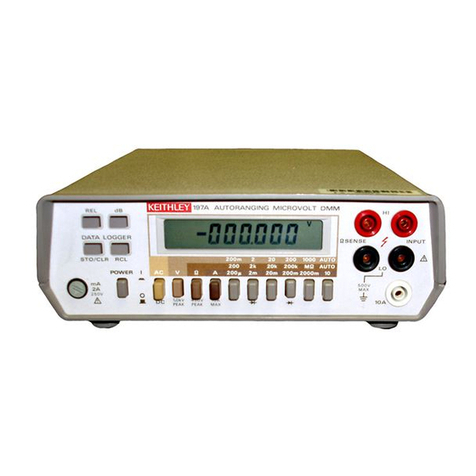
Keithley
Keithley 197A User manual
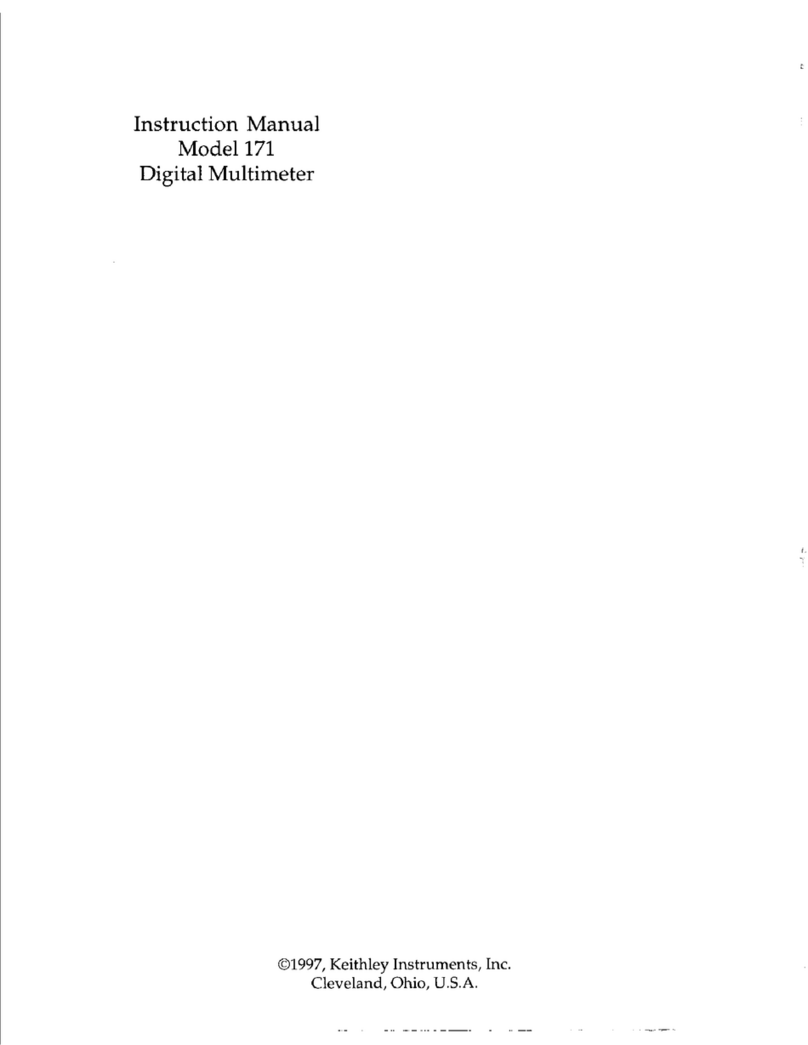
Keithley
Keithley 171 User manual
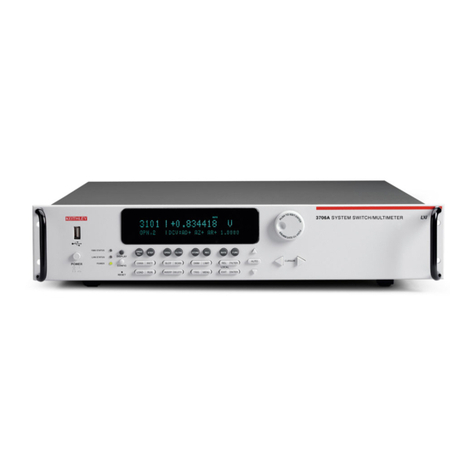
Keithley
Keithley 3700A Series User manual
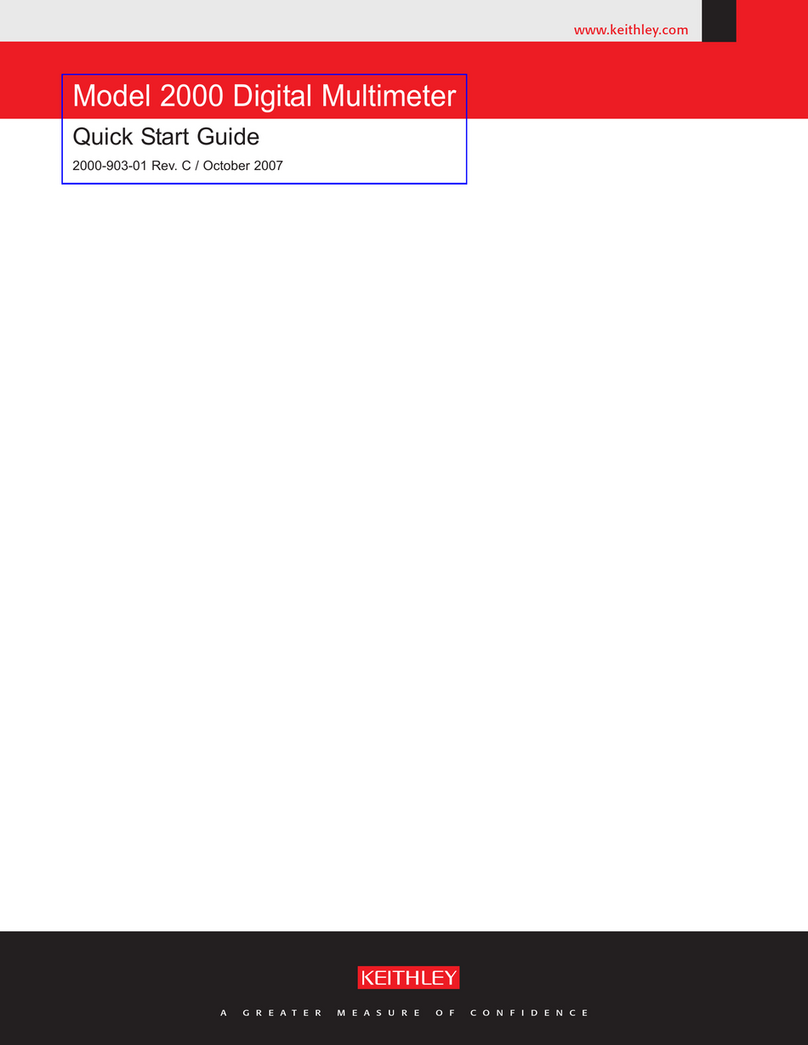
Keithley
Keithley 2000 User manual
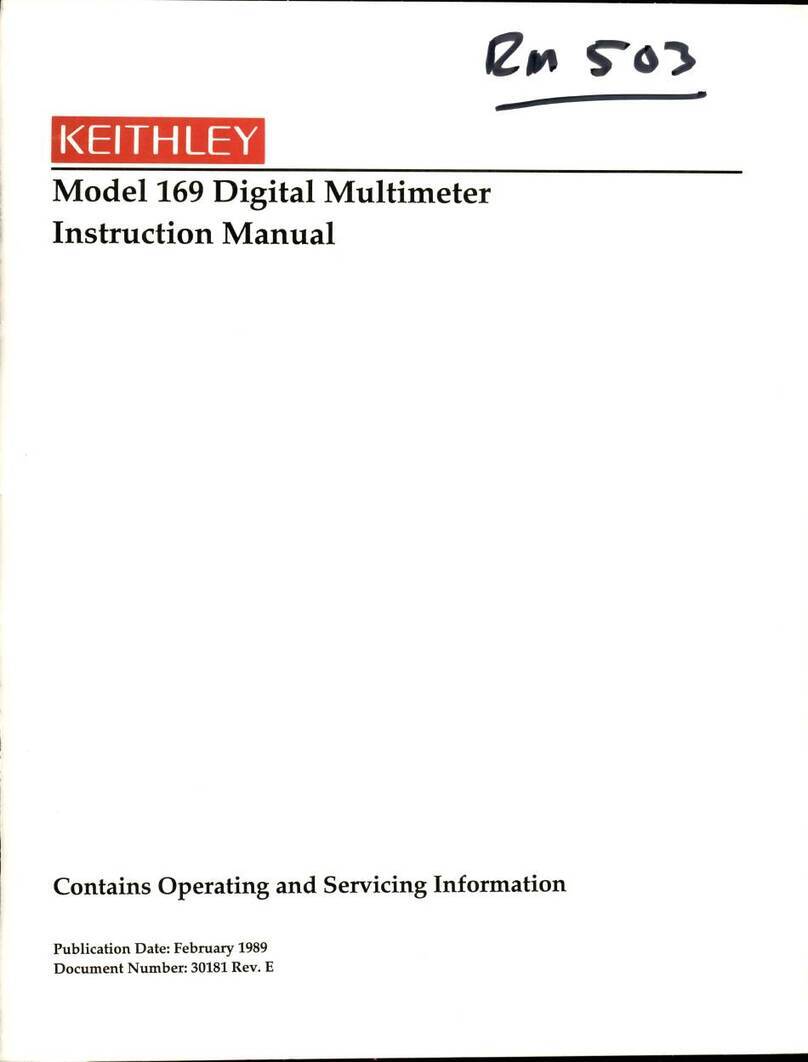
Keithley
Keithley 169 User manual
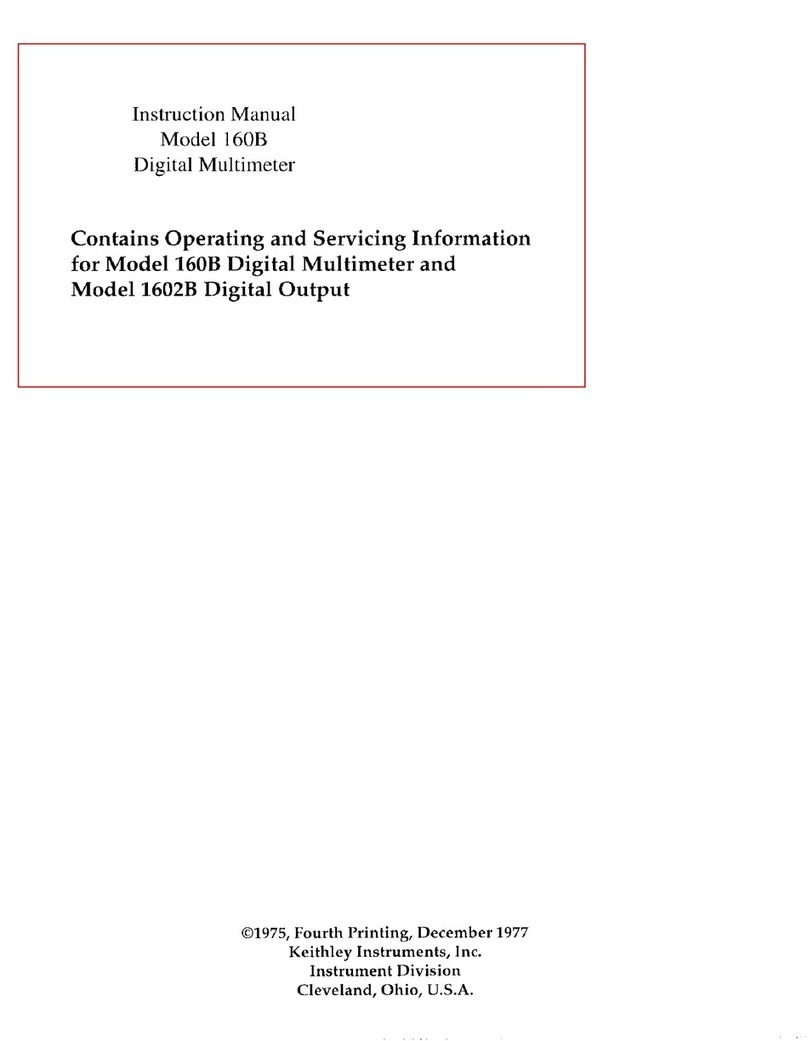
Keithley
Keithley 160B User manual
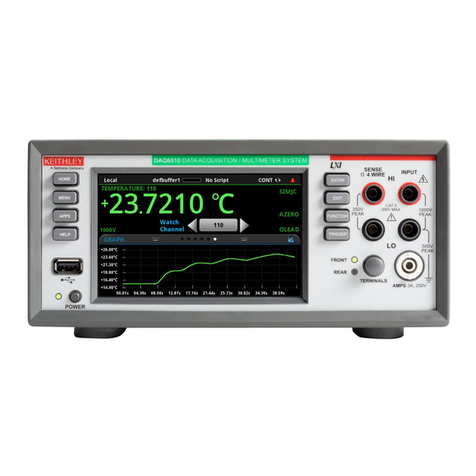
Keithley
Keithley DAQ6510 User manual
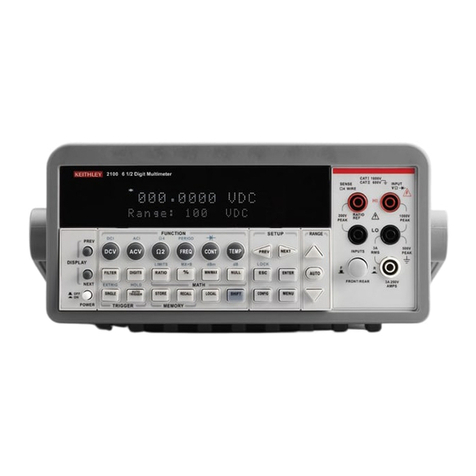
Keithley
Keithley 2000 Use and care manual

Keithley
Keithley 2010 User manual
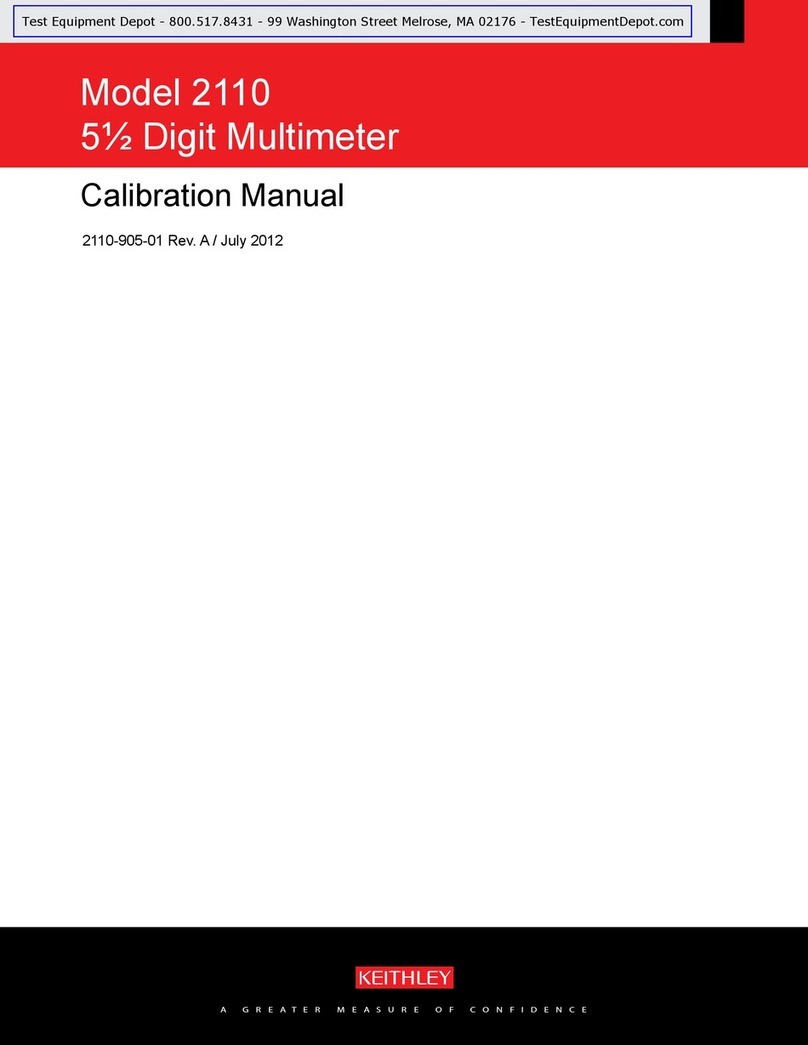
Keithley
Keithley 2110-100 Use and care manual
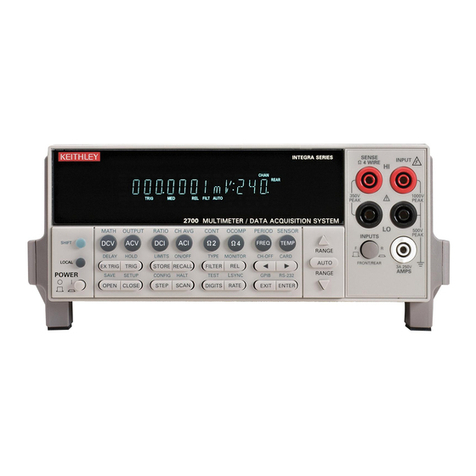
Keithley
Keithley 2700 User manual
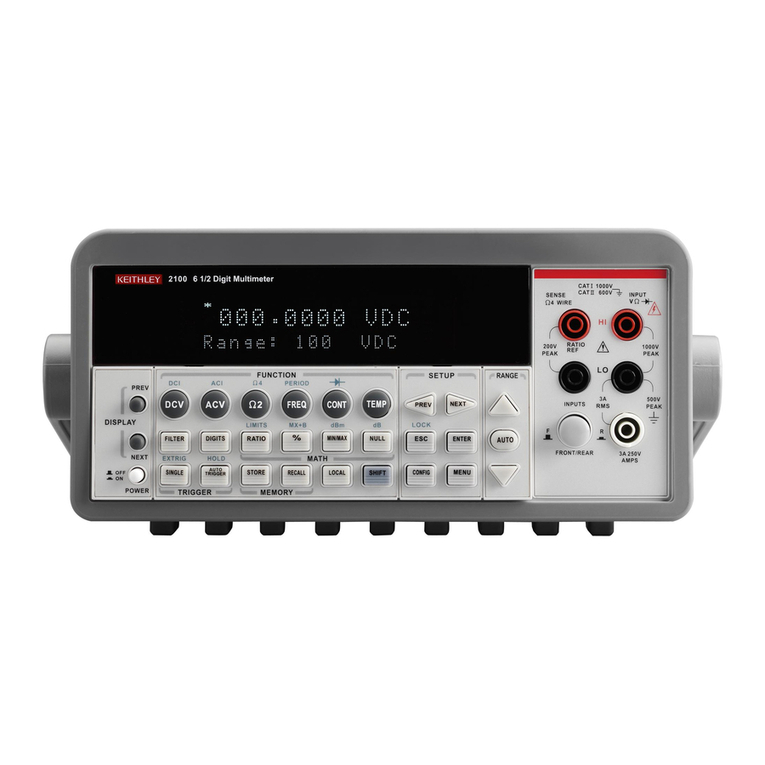
Keithley
Keithley 2100 User manual
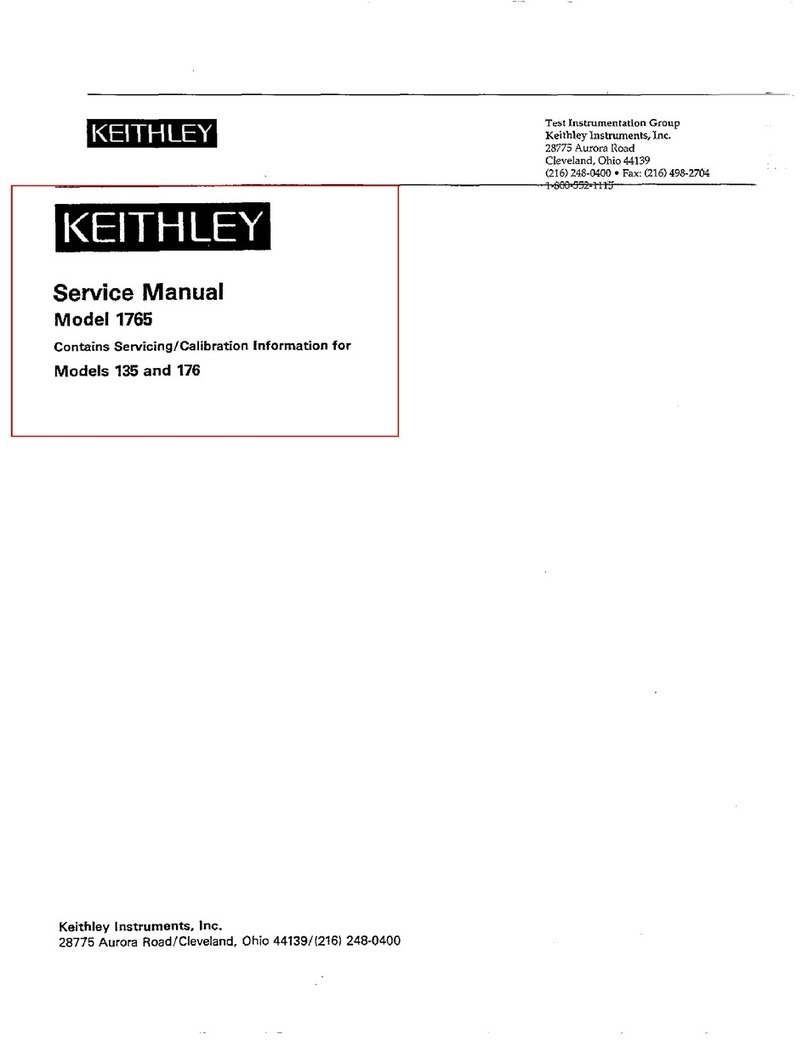
Keithley
Keithley 1765 User manual

Keithley
Keithley DMM7510 User manual
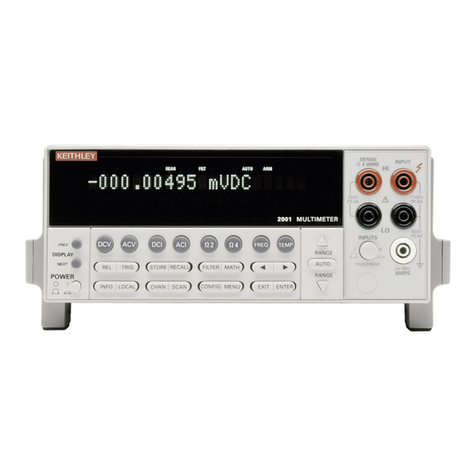
Keithley
Keithley 2001 Operating instructions

Keithley
Keithley 175 User manual
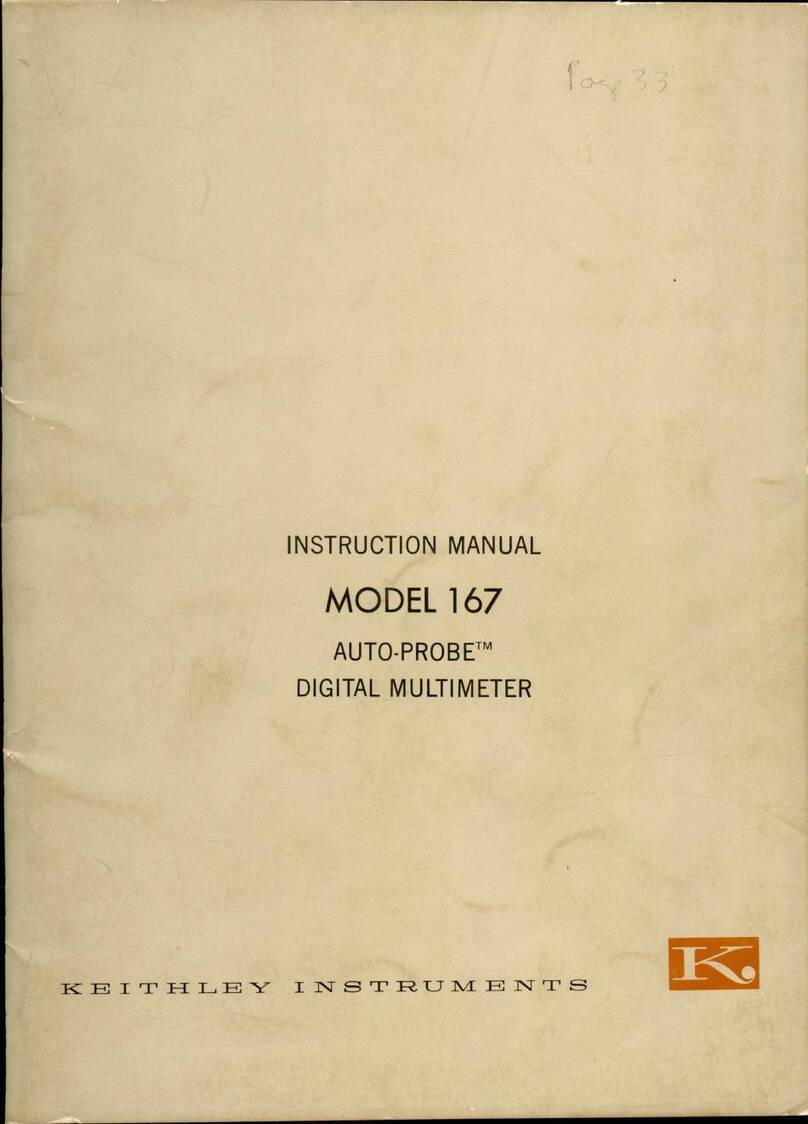
Keithley
Keithley AUTO-PROBE 167 User manual
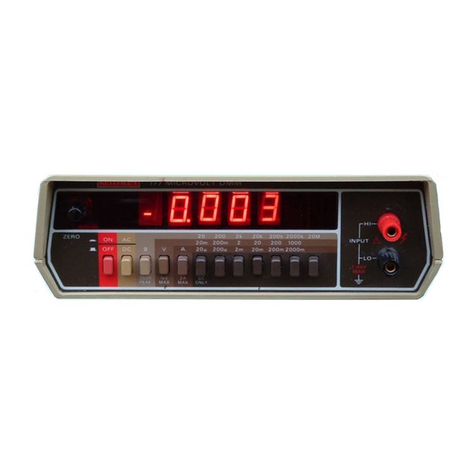
Keithley
Keithley 177 User manual
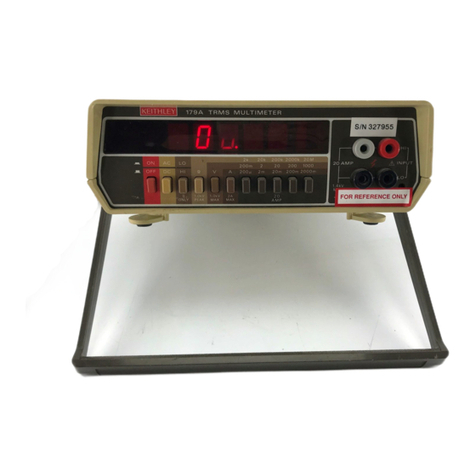
Keithley
Keithley 179A User manual
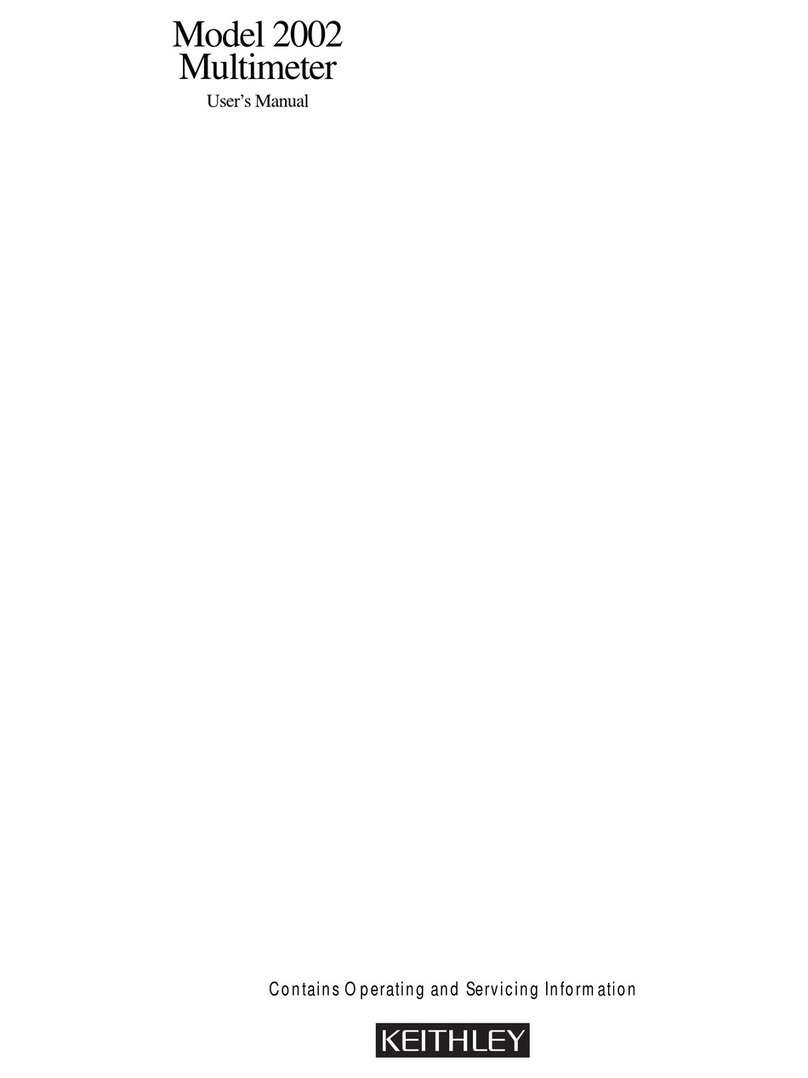
Keithley
Keithley 2002 User manual


